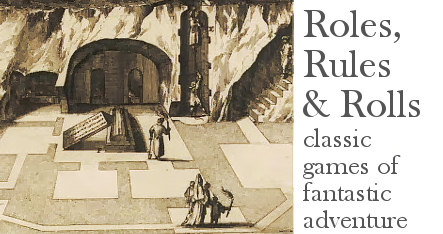I don't think there's any argument that by whatever name, kitsch or overload is the dominant form in the aesthetics of both commercial and DIY adventure gaming. In fact, it can be broken down into three elements of style that begin with an "A". The first one is the overload of Archaism.
Archaism kitsch can be seen in the way artists choose to depict that quintessential adventure setting, the dungeon. Number one earmark is the set-dressing habit of "dungeon architecture." The classic fieldstone walls and ensconced torches have a tendency to adorn even chambers deep in the earth that should be hewn out of the living rock, and where torches would quickly consume all available oxygen, even if there were minions to replace them on the hour ...
The reason for the overload: if you just have economical 5' passages hewn through stone, they could be anything - a Cold War bunker entrance, a Minoan adit, a university steam tunnel. The stone blocks and iron-reinforced doors yell "Castle!" as loudly as they can. But this is not an inevitable choice. Here's an illustration by John Bingham, from Mouth of the Shadowvein, that manages to avoid the medieval style of Archaic dungeon overload (although doubling down on Adversity with its centipede floor):
The bas-reliefs, however, remind us that another way to convey Archaism is to raid the archaeological toybox: statues, reliefs, mosaics, skull doors and demon thrones. In fact, the default overload response to "What part of antiquity?" is "All of it." So we derive the typical adventure setting with its anachronistic cohabitation of Roman, Dark Age, High Medieval, cod-Renaissance, and Nation X imitations.
Fanciful depictions of never-were civilizations and lost races also go in the mix, the costumes and scenery derived from a mix of medieval and faux-barbaric sources, with sex appeal turned way up. Compare the standard loincloths-and-bangles "Conanesque" setting with ones such as Tekumel, drawing on similar source material, but with more originality.
Focus on any one period of history, and you lose the freedom of archaic overload. If the setting is medieval, the question becomes how medieval - fairy-tale medieval, or boils-and-rats medieval? The more representational you get when it comes to history, the more you have to worry about things that make history boring - for example, a party of freebooting adventurers would almost certainly be outlawed in every jurisdiction of a feudal society. So paradoxically, even as dungeon kitsch evokes the medieval, it also avoids its hard questions.
To illustrate -- early gaming illustrations, a stone's throw away from medieval wargaming, felt free to present fairly realistic armaments:
 |
| David C Sutherland III |
And still later, illustrations cranked up the depiction of the next overload element: Adversity. Yes, even on a costume. More next time.





How would you respond to the idea that the things in games, even the pictures like the ones shown above, are tools, and that tools are pulled towards conservatism not by a desire for kitsch or overload but because consertative tools are often very useful tools.
ReplyDeleteEvery standard stone-flagged dungeon section is a space you don't have to think too much about, which means the things in it can be regarded more freely and easily.
Tekumel is a good example. Whate the differenee between a Tekumel game and a Conanesque game. The most powerful immediate difference is that in a conanesque game *you don't have to spend half an hour explaining Tekumel* , everyone knows what everything is straight away and can start making choices with that information striaght away.
Even if you want to do very interesting things it can be easier to present them and move between them by connecting them with standard conservative ideas.
I would agree that's one function of the genre-typical, and something I lean on in my own games. I'm not so sure that basing more inventive material upon it gives the same end-product reaction as thoroughly embracing, intensifying and redoubling it, though. It's the possibility of the latter I want to examine here.
DeleteAnd I have YET MORE TO SAY, apparently.
ReplyDeleteBased purely on the pictures above, the arms, that is the weapons being wielded, are almost exaclt as accurate in both images. True, the kender has some catapult thing, but the swords, sablre and bow are correctly-propotioned, plus wtf is the wizard up to in the Sutherland image?
The Elmore has strange less-realistic armour in it. It also has women in it. because women play the game, and it represents the game. Is that 'overload'.
Plus what is the wizard *wearing* in the Sutherland image. Dragonlance is 'overload', maybe. But a guy wearing a pointy fucking hat with *stars* in it in a natural cavern with a *flat floor* is not kitsch?
Plus, neither of these images are that good but the one below is just *better*. It is better becasue it is not fucking ugly.
"freedom of archaic overload"
"Things that make history boring"
"avoid its hard questions"
Interesting criticisms of an art or a thesis paper, but not of a game, whose whole point is *not to be boring*, that being the reason for its existance.
I apologise for the apparent fury of my relentless and seemingly overwhelming opposition to your idea but I really do disagree in the strongest terms.
Well, I was trying to focus in on just the fighterly figures in those images, not making a point about gender, wizards, technical merit or cavern floors, to explain the point about a pan-historical antiquity being more "overloaded" than one rooted in historical specifics. That approach being more fun is also one possible reason why it is embraced or seen as some kind of epitome. I'm not meaning to make the prescriptive points you think I am, but maybe my language implies otherwise ...?
ReplyDelete